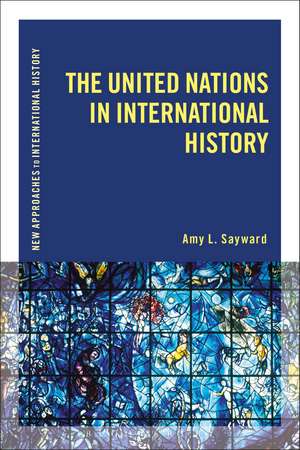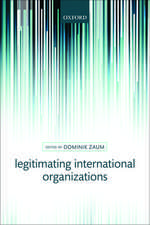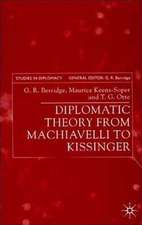The United Nations in International History: New Approaches to International History
Autor Amy L. Saywarden Limba Engleză Paperback – 22 feb 2017
| Toate formatele și edițiile | Preț | Express |
|---|---|---|
| Paperback (1) | 201.34 lei 6-8 săpt. | |
| Bloomsbury Publishing – 22 feb 2017 | 201.34 lei 6-8 săpt. | |
| Hardback (1) | 600.88 lei 6-8 săpt. | |
| Bloomsbury Publishing – 22 feb 2017 | 600.88 lei 6-8 săpt. |
Din seria New Approaches to International History
- 19%
 Preț: 168.15 lei
Preț: 168.15 lei - 8%
 Preț: 154.50 lei
Preț: 154.50 lei -
 Preț: 160.19 lei
Preț: 160.19 lei -
 Preț: 144.84 lei
Preț: 144.84 lei - 7%
 Preț: 134.66 lei
Preț: 134.66 lei - 7%
 Preț: 149.02 lei
Preț: 149.02 lei - 17%
 Preț: 177.88 lei
Preț: 177.88 lei - 7%
 Preț: 148.75 lei
Preț: 148.75 lei - 8%
 Preț: 153.45 lei
Preț: 153.45 lei - 14%
 Preț: 165.91 lei
Preț: 165.91 lei - 13%
 Preț: 167.24 lei
Preț: 167.24 lei - 13%
 Preț: 180.88 lei
Preț: 180.88 lei - 14%
 Preț: 186.19 lei
Preț: 186.19 lei - 13%
 Preț: 176.74 lei
Preț: 176.74 lei - 14%
 Preț: 147.24 lei
Preț: 147.24 lei - 23%
 Preț: 192.36 lei
Preț: 192.36 lei - 7%
 Preț: 149.02 lei
Preț: 149.02 lei - 7%
 Preț: 148.29 lei
Preț: 148.29 lei - 21%
 Preț: 217.91 lei
Preț: 217.91 lei - 20%
 Preț: 219.46 lei
Preț: 219.46 lei - 13%
 Preț: 180.88 lei
Preț: 180.88 lei - 23%
 Preț: 192.30 lei
Preț: 192.30 lei - 30%
 Preț: 571.01 lei
Preț: 571.01 lei - 14%
 Preț: 539.25 lei
Preț: 539.25 lei - 23%
 Preț: 191.75 lei
Preț: 191.75 lei - 22%
 Preț: 227.23 lei
Preț: 227.23 lei - 30%
 Preț: 510.68 lei
Preț: 510.68 lei - 13%
 Preț: 175.85 lei
Preț: 175.85 lei - 22%
 Preț: 656.47 lei
Preț: 656.47 lei
Preț: 201.34 lei
Preț vechi: 231.54 lei
-13% Nou
Puncte Express: 302
Preț estimativ în valută:
38.53€ • 40.08$ • 31.81£
38.53€ • 40.08$ • 31.81£
Carte tipărită la comandă
Livrare economică 15-29 aprilie
Preluare comenzi: 021 569.72.76
Specificații
ISBN-13: 9781472510037
ISBN-10: 1472510038
Pagini: 328
Dimensiuni: 156 x 234 x 19 mm
Greutate: 0.52 kg
Editura: Bloomsbury Publishing
Colecția Bloomsbury Academic
Seria New Approaches to International History
Locul publicării:London, United Kingdom
ISBN-10: 1472510038
Pagini: 328
Dimensiuni: 156 x 234 x 19 mm
Greutate: 0.52 kg
Editura: Bloomsbury Publishing
Colecția Bloomsbury Academic
Seria New Approaches to International History
Locul publicării:London, United Kingdom
Caracteristici
Integrates more traditional diplomatic history with newer currents in transnational and cultural history
Notă biografică
Amy L. Sayward is Professor of History at Middle Tennessee State University, USA.
Cuprins
List of FiguresSeries Editor's PrefacePreface and AcknowledgmentsForewordList of Abbreviations1. Introduction: An Invitation2. The National and International Origins of the United Nations3. The Cold War Borderland4. Preventing War and Promoting Peace through Social and Economic Programs 5. The Development Enterprise6. Making and Keeping the Peace: U.N. Peace-Keeping and Refugee Assistance Operations7. The Middle East and the United Nations8. Defining Human Rights, International Justice, and Genocide9. Conclusion: Join the Conversation!NotesIndex
Recenzii
Useful for students and teachers who are interested in international and especially UN history. (Bloomsbury Translation)
Sayward's book is a welcome introduction to the United Nations . It will be especially useful in introductory-level courses on the United Nations and upper-level classes on international history, as students will find much value in her rich overview. Her book also serves as a valuable starting point for graduate students, scholars, and journalists seeking an authoritative guide to the UN system and the growing body of scholarship dedicated to analyzing its history.
Amy Sayward had written a superbly balanced and comprehensive overview of how the United Nations has evolved and how it works. This book is a "must-read" primer for students and educators, young and older, as well as journalists and diplomats first embarking on U.N. assignments and needing perspective on the history of our most significant international organization, one that indeed has changed global society since World War II. Historians in particular will find Sayward's account a most valuable resource summarizing the U.N.'s past and aiding any assessment of its future.
A superb introduction to the UN's multifaceted role in the world, The United Nations in International History is an essential resource for students of internationalism and international governance. Combining masterful analyses of long-term developments with brisk, in-depth studies of key issues-from antecedents in 19th century scientific organizations to peacekeeping, refugee assistance, and human rights-Amy Sayward expertly charts a course through the history of the UN, its many agencies and functions, and its relations with other actors. With enticing suggestions for further research sprinkled throughout, this wonderful book is certain to energize the next wave of UN studies.
United Nations diplomacy is multi-tonal and not monolithic. As such, the organisation provides a vital setting and source-base for working with diplomatic history and wider transnational histories. Across a variety of geographies, themes and global political contestations undertaking research on the United Nations offers a stimulating journey for exploring the major issues of our recent past and the present. Amy L. Sayward has produced a broad-ranging and most helpful introduction to how the United Nations can be a rich and rewarding subject of study for interested students and researchers.
Sawyard provides a comprehensive overview of the institution's scope of action in the international arena ... The monograph provides strong evidence of continuities at the institutional level and in daily practices.
Sayward's book is a welcome introduction to the United Nations . It will be especially useful in introductory-level courses on the United Nations and upper-level classes on international history, as students will find much value in her rich overview. Her book also serves as a valuable starting point for graduate students, scholars, and journalists seeking an authoritative guide to the UN system and the growing body of scholarship dedicated to analyzing its history.
Amy Sayward had written a superbly balanced and comprehensive overview of how the United Nations has evolved and how it works. This book is a "must-read" primer for students and educators, young and older, as well as journalists and diplomats first embarking on U.N. assignments and needing perspective on the history of our most significant international organization, one that indeed has changed global society since World War II. Historians in particular will find Sayward's account a most valuable resource summarizing the U.N.'s past and aiding any assessment of its future.
A superb introduction to the UN's multifaceted role in the world, The United Nations in International History is an essential resource for students of internationalism and international governance. Combining masterful analyses of long-term developments with brisk, in-depth studies of key issues-from antecedents in 19th century scientific organizations to peacekeeping, refugee assistance, and human rights-Amy Sayward expertly charts a course through the history of the UN, its many agencies and functions, and its relations with other actors. With enticing suggestions for further research sprinkled throughout, this wonderful book is certain to energize the next wave of UN studies.
United Nations diplomacy is multi-tonal and not monolithic. As such, the organisation provides a vital setting and source-base for working with diplomatic history and wider transnational histories. Across a variety of geographies, themes and global political contestations undertaking research on the United Nations offers a stimulating journey for exploring the major issues of our recent past and the present. Amy L. Sayward has produced a broad-ranging and most helpful introduction to how the United Nations can be a rich and rewarding subject of study for interested students and researchers.
Sawyard provides a comprehensive overview of the institution's scope of action in the international arena ... The monograph provides strong evidence of continuities at the institutional level and in daily practices.









